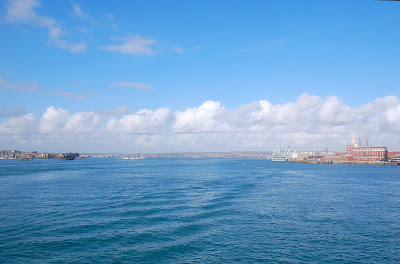This weekend, I was lucky enough to visit a few of the Ring of Kerry historical sites with my archaeology class, checking out a few Early Medieval sites on the Dingle coast.
We started off our day visiting the two ringforts of the local king, and could see out onto the island where the Vikings made their base and Church Island, the royally funded ecclesiastic settlement. These where interesting sites, which you can read all about in the next issue of the Trident
 |
| Doesn't this look interesting? Good thing the Trident is free |
After a quick stop for lunch, we drove down to our next site. Or rather, we drove down to our walk down to our next stop-- first we had to walk over a mile through the winding, muddy dirt path to the site, hopping over some animal dung and fences for good measure. Apparently the path use to be in much better repair, until the local highway was paved and stole all the traffic. But I could use some more cardio, so it was probably worth it.
The site we ended up going to was an old church from the Early Medieval period, no longer in a ruinous state. Unfortunately, it was no longer in ruins not because a good conservation effort, but because those Late Medieval churchmen decided it would be easier to make headstones by looting the looting the old church than quarrying out new stones. The church site is on the side of a mountain overlooking a local ringfort
 |
| This small rectangle use to be either a private church for the monks or a shrine-- I promise |
While the buildings were no longer standing, and the landscape covered in the gravestones of Late Medieval burials, with a keen eye you could still juuuust make out the trenches and earthworks that marked out the enclosure of the church site, and the inner enclosure of the holiest area of the settlement. Early Irish church sites were frequently divided into two or three sections in order of "holiness" (this site had two sections)-- the holiest area, called
sanctissimus, would have the church proper, as well as any shrines or graves, and the less holy area would have housing for the ordained, craft sites (such as a forge or tannery) and other ordinary activities. The outer enclosure of the site was just as import, if not more, marking the limits of what was considered the sanctified land. This enclosure had great legal and political importance, since land couldn't really be taken away from the church (while it legally could, it would be a good way of looking like a tyrant) so a king giving rival's lands to the church was an effective way of prevent them from regaining power (such as what happened at the Rock of Cashel), and it was a place of sanctuary, where criminals or soldiers could flee to escape violence (people rarely followed the spirit of the law though, so the annals record a lot of people being dragged out of the churches and executed right outside the gate).
More visible were the cross-slabs, a type of standing stone common at early church sites carved with the image of the cross (hence the creative name).
 |
| The more decorated cross-slab |
There are three cross-slabs, one very decorated to look like a Coptic altar-piece-- showing a surprising connection between the Irish monasteries and Egypt-- and the other two having much smaller and plainer crosses carved into them. One theory is that we're missing a fourth cross-slab, either destroyed or looted, and that these four slabs would act as the cornerstones to a pillar-shrine; under this model this central axis of the shrine would have pointed towards Skellig Michael, a rocky island once famous for the Early Medieval religious hermits that lived in solitude at its peak and now famous for being where Luke hides in Star Wars
 |
| Spoiler alert: about five seconds ago I gave away the ending to The Force Awakens |
I'm not particularly convinced of this. Partially because if the "missing" cross-slab was reused as a grave stone, the others would have probably been nicked as well, and there would be a nice hole where the stone was buried to stand up. Also because I feel we don't need a fourth stone. The way that the stone are standing, we have the nice slab with the Coptic cross two yards or so before the plain cross slabs, roughly in line with one another. If we imagine these as forming a triangle, we have the image of Christ's cross (the fancy one) between the two thieves on Mount Calvary
 |
| See? |
This would shift the central axis away from Skellig Michael. But wait! Remember how Mount Calvary was a mountain overlooking the walls of Jerusalem? Well, now our little crucifixion scene is overlooking...
The ringfort in the valley bellow!
After putting those years in Catholic school to good use, it was time to make the hike through the muddy, dung-covered, overgrown dirt road, but with added fun from going up hill this time, ending a fun day of archaeological adventures.









































